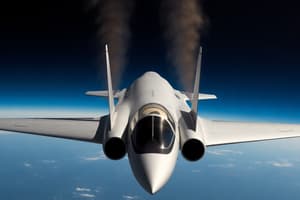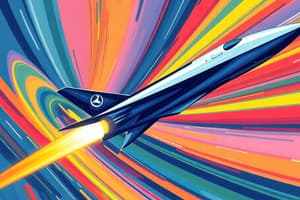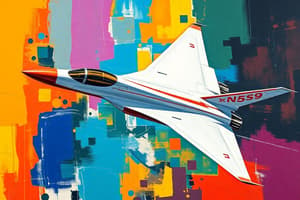Podcast
Questions and Answers
Which country was the first to achieve supersonic flight with the Tupolev Tu-144?
Which country was the first to achieve supersonic flight with the Tupolev Tu-144?
- France
- United States
- United Kingdom
- Soviet Union (correct)
In which year did the Anglo-French Concorde make its first flight?
In which year did the Anglo-French Concorde make its first flight?
- 1947
- 1976
- 1969 (correct)
- 1968
What caused the withdrawal of the Tupolev Tu-144 from service in 1978?
What caused the withdrawal of the Tupolev Tu-144 from service in 1978?
- Elegance
- Insufficient speed
- Technological limitations
- Poor reliability and safety concerns (correct)
Who successfully broke the sound barrier in 1947?
Who successfully broke the sound barrier in 1947?
What does SST stand for in the context of supersonic flight?
What does SST stand for in the context of supersonic flight?
When did the Concorde enter service?
When did the Concorde enter service?
Why was the Boeing 2707 project eventually abandoned in 1971?
Why was the Boeing 2707 project eventually abandoned in 1971?
What distinctive design feature did the Concorde have for superior visibility?
What distinctive design feature did the Concorde have for superior visibility?
Why did the focus of the aviation industry shift towards subsonic aircraft after the Concorde's retirement?
Why did the focus of the aviation industry shift towards subsonic aircraft after the Concorde's retirement?
What is the current status of supersonic passenger aircraft development?
What is the current status of supersonic passenger aircraft development?
What impact did the Concorde have on the future of air travel?
What impact did the Concorde have on the future of air travel?
Study Notes
The Evolution of Supersonic Flight
Supersonic flight, abbreviated as SST (Supersonic Transport), refers to the ability of an aircraft to travel faster than the speed of sound, or Mach 1. This revolutionary form of air travel has a rich history, filled with groundbreaking achievements and ambitious goals. Let's delve into the evolution of SST, starting from its inception in the 1950s.
The Dawn of SST
The quest for supersonic flight began in the early 20th century, but it wasn't until the 1950s that serious research and development started. After the success of breaking the sound barrier by Chuck Yeager in 1947, the United States and the Soviet Union turned their sights towards creating a supersonic passenger aircraft. The Anglo-French Concorde, the most successful and iconic SST, first flew in 1969 and entered service in 1976, but it wasn't the first SST.
The Soviet Union's Tupolev Tu-144, the first operational SST, made its first flight in 1968, and it entered commercial operation in 1977. However, the Tu-144 faced numerous issues and was later withdrawn from service in 1978 due to poor reliability and safety concerns.
The Concorde
The Concorde, a joint project between the United Kingdom and France, was the pinnacle of SST development during its time. The Concorde was a beautiful marriage of elegance and technology, capable of crossing the Atlantic in less than three hours. Its first flight took place in 1969, and it entered service in 1976, operating until 2003 due to declining passenger numbers and high operating costs.
The Concorde's design was the result of decades of research and development, with engineers and scientists from both countries working tirelessly to overcome the immense technical challenges associated with supersonic flight. The aircraft's distinctive "droop nose" design allowed for superior visibility, and its unique design made it an awe-inspiring sight to see.
The Boeing 2707
The Boeing 2707, a proposed SST developed by Boeing in the United States in the 1960s and 1970s, was the American response to the Anglo-French Concorde. The Boeing 2707 was intended to be a larger, more efficient version of the Concorde, capable of carrying more passengers and traveling longer distances. After extensive research and development, the project was eventually abandoned in 1971 due to concerns over the aircraft's environmental impact and high operating costs.
The End of SST and Future Prospects
The Concorde, the last major SST to operate commercially, was retired in 2003 due to declining passenger numbers and high operating costs. After the Concorde's retirement, the focus of the aviation industry shifted towards more efficient subsonic aircraft and the development of new technologies that would make supersonic flight more viable in the future.
Today, supersonic flight remains the realm of military aircraft, with little progress towards the development of new SSTs for commercial use. However, numerous companies, including Boom Supersonic, Spike Aerospace, and Aerion Supersonic, are working on new supersonic passenger aircraft designs. The success of these projects remains to be seen, but they hold the promise of revitalizing supersonic travel and opening up new possibilities for the future of air travel.
In conclusion, the evolution of SST has been a fascinating and complex journey, shaping the future of air travel in ways we could never have imagined. While the Concorde may be gone, the dreams of supersonic flight continue to inspire and drive innovation in the aviation industry. Only time will tell if the future of SST will be as bright as the Concorde's golden age, but it's an exciting prospect that keeps us looking towards the skies.
Studying That Suits You
Use AI to generate personalized quizzes and flashcards to suit your learning preferences.
Description
Test your knowledge on the evolution of supersonic flight, from the early research and development to the iconic Concorde and the challenges faced by projects like the Boeing 2707. Explore the history, achievements, and future prospects of supersonic travel in this quiz.





